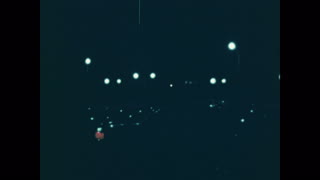“In the 20th century, man overcame his crawling and he is now poised at the very threshold of the stars.” That dramatic sentence opens the mid-1960s National Aeronautics and Space Administration (NASA) – Goddard Space Flight Center film. “The Vital Link.” The color film introduces audiences to those trackers who never leave Earth but whose missions are essential to astronauts’ “getting out and getting back.” Near mark 01:00 we hear a radio news broadcast of how Goddard Space Flight Center engineers in Maryland are preparing to launch a Nimbus weather satellite, and at mark 01:45 we see inside a launch center with scientists and engineers shown sitting in front of gigantic monitors and radar screens, receiving and transmitting data. It is but one part of a network of centers that track and coordinate satellites, manned spaceflight, and deep space unmanned missions, we are told. At mark 05:23 we are taken to Cadbury, Australia, where three NASA tracking stations (including one designed to track Apollo moon-landing missions) are located. Back at Goddard at mark 07:45, the narrator comments on some of the wonders of space that various satellites had “seen” including solar flares and micrometeorites, with the collected data analyzed in published in reports (mark 08:22). The results inspire new ideas and new experiments.
After reiterating tracking, telemetry, and command as being the three key elements to any ground tracking station, we see more of the satellites used in tracking including dish antennae and slot antennae. We’re also transported to a scientific and industrial research station across the globe as the film continues, including one in South Africa, where scientists are shown collecting data from the a Pioneer satellite in orbit around the sun. (The satellites helped track solar magnetic storms). Deep space station also collect data from the Surveyor and Mariner spacecraft as scientists are shown operating computers that take up an entire room (mark 13:15). Among the data collected — a fantastic “Earthrise” image, shown at mark 17:00. Astronauts in a test capsule, preparing for a lunar landing, are shown starting at mark 18:40, as the narrator says tracking station personnel undergo similar and extensive training for upcoming missions to the moon. The moon flight simulation continues with tracking stations working together. Researchers track the simulated moon mission’s “return” to Earth at mark 25:30. “The further you go into space the more tracking becomes a vital link in bringing you and your findings back,” concludes the narrator at mark 28:08.


